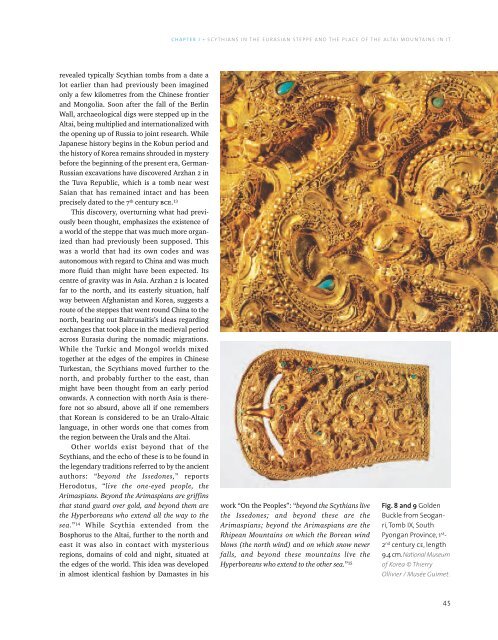Scythian Culture - Preservation of The Frozen Tombs of The Altai Mountains (UNESCO)
Create successful ePaper yourself
Turn your PDF publications into a flip-book with our unique Google optimized e-Paper software.
CHAPTER I • SCYTHIANS IN THE EURASIAN STEPPE AND THE PLACE OF THE ALTAI MOUNTAINS IN IT<br />
revealed typically <strong>Scythian</strong> tombs from a date a<br />
lot earlier than had previously been imagined<br />
only a few kilometres from the Chinese frontier<br />
and Mongolia. Soon after the fall <strong>of</strong> the Berlin<br />
Wall, archaeological digs were stepped up in the<br />
<strong>Altai</strong>, being multiplied and internationalized with<br />
the opening up <strong>of</strong> Russia to joint research. While<br />
Japanese history begins in the Kobun period and<br />
the history <strong>of</strong> Korea remains shrouded in mystery<br />
before the beginning <strong>of</strong> the present era, German-<br />
Russian excavations have discovered Arzhan 2 in<br />
the Tuva Republic, which is a tomb near west<br />
Saian that has remained intact and has been<br />
precisely dated to the 7 th century bce. 13<br />
This discovery, overturning what had previously<br />
been thought, emphasizes the existence <strong>of</strong><br />
a world <strong>of</strong> the steppe that was much more organized<br />
than had previously been supposed. This<br />
was a world that had its own codes and was<br />
autonomous with regard to China and was much<br />
more fluid than might have been expected. Its<br />
centre <strong>of</strong> gravity was in Asia. Arzhan 2 is located<br />
far to the north, and its easterly situation, half<br />
way between Afghanistan and Korea, suggests a<br />
route <strong>of</strong> the steppes that went round China to the<br />
north, bearing out Baltrusaïtis’s ideas regarding<br />
exchanges that took place in the medieval period<br />
across Eurasia during the nomadic migrations.<br />
While the Turkic and Mongol worlds mixed<br />
together at the edges <strong>of</strong> the empires in Chinese<br />
Turkestan, the <strong>Scythian</strong>s moved further to the<br />
north, and probably further to the east, than<br />
might have been thought from an early period<br />
onwards. A connection with north Asia is therefore<br />
not so absurd, above all if one remembers<br />
that Korean is considered to be an Uralo-<strong>Altai</strong>c<br />
language, in other words one that comes from<br />
the region between the Urals and the <strong>Altai</strong>.<br />
Other worlds exist beyond that <strong>of</strong> the<br />
<strong>Scythian</strong>s, and the echo <strong>of</strong> these is to be found in<br />
the legendary traditions referred to by the ancient<br />
authors: “beyond the Issedones,” reports<br />
Herodotus, “live the one-eyed people, the<br />
Arimaspians. Beyond the Arimaspians are griffins<br />
that stand guard over gold, and beyond them are<br />
the Hyperboreans who extend all the way to the<br />
sea.” 14 While Scythia extended from the<br />
Bosphorus to the <strong>Altai</strong>, further to the north and<br />
east it was also in contact with mysterious<br />
regions, domains <strong>of</strong> cold and night, situated at<br />
the edges <strong>of</strong> the world. This idea was developed<br />
in almost identical fashion by Damastes in his<br />
work “On the Peoples”: “beyond the <strong>Scythian</strong>s live<br />
the Issedones; and beyond these are the<br />
Arimaspians; beyond the Arimaspians are the<br />
Rhipean <strong>Mountains</strong> on which the Borean wind<br />
blows (the north wind) and on which snow never<br />
falls, and beyond these mountains live the<br />
Hyperboreans who extend to the other sea.” 15<br />
Fig. 8 and 9 Golden<br />
Buckle from Seoganri,<br />
Tomb IX, South<br />
Pyongan Province, 1 st -<br />
2 nd century ce, length<br />
9.4 cm. National Museum<br />
<strong>of</strong> Korea © Thierry<br />
Ollivier / Musée Guimet.<br />
45
















